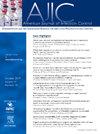伊朗门诊患者的抗生素处方流行率:伊朗门诊病人的抗生素处方流行率:关注定义的每日剂量和 AWaRe 分类系统。
IF 3.8
3区 医学
Q2 INFECTIOUS DISEASES
引用次数: 0
摘要
背景:抗生素的不当使用和过量处方对全球健康构成威胁,尤其是导致了抗菌药耐药性。本研究旨在使用定义的每日剂量和获取、观察和储备(AWaRe)分类系统评估伊朗门诊患者的抗生素处方流行率:这项回顾性研究分析了 2022 年 3 月至 2023 年 3 月期间伊朗德黑兰的全身用抗生素电子处方。数据来自伊朗医疗保险组织,采用跨行业标准流程进行处理。结果:共分析了 817,178 份抗生素处方,其中女性占 57.43%,年龄中位数为 48 岁。每位患者平均每张处方使用 1.89 种抗生素。超过 63% 的抗生素被归为 "观察 "类,其中阿奇霉素是最常用的处方药(27.56%)。总DID为4.99,全科医生占处方的58.02%,主要处方为阿奇霉素:研究强调了观察组抗生素的高使用率,表明有必要改进处方做法。有必要开展抗生素管理教育并制定更严格的指导方针,以消除抗菌药耐药性。持续监测对于优化伊朗门诊抗生素的使用至关重要。本文章由计算机程序翻译,如有差异,请以英文原文为准。
Antibiotic prescription prevalence in Iranian outpatients: A focus on defined daily doses and the AWaRe classification system
Background
The inappropriate use and overprescription of antibiotics pose a global health threat, particularly contributing to antimicrobial resistance. This study aims to evaluate antibiotic prescription prevalence in Iranian outpatients using the defined daily doses (DDD) and Access, Watch, and Reserve classification systems.
Methods
This retrospective study analyzed electronic prescriptions for systemic antibiotics in Tehran, Iran, from March 2022 to March 2023. The data were obtained from the Iranian Health Insurance Organization and processed using the Cross-Industry Standard Process. Descriptive statistics and DDD per 1,000 inhabitants per day were calculated.
Results
A total of 817,178 antibiotic prescriptions were analyzed, with a sex distribution of 57.43% female and a median age of 48 years. On average, each patient received 1.89 antibiotics per prescription. Over 63% of antibiotics were classified in the "Watch" category, with Azithromycin being the most commonly prescribed (27.56%). The total DDD per 1,000 inhabitants per day was 4.99, with general practitioners accounting for 58.02% of the prescriptions, primarily prescribing Azithromycin.
Conclusions
The study emphasizes the high use of Watch group antibiotics, indicating a need for improved prescribing practices. Education on antibiotic stewardship and stricter guidelines are necessary to combat antimicrobial resistance. Continuous monitoring is crucial to optimize antibiotic use in outpatient settings in Iran.
求助全文
通过发布文献求助,成功后即可免费获取论文全文。
去求助
来源期刊
CiteScore
7.40
自引率
4.10%
发文量
479
审稿时长
24 days
期刊介绍:
AJIC covers key topics and issues in infection control and epidemiology. Infection control professionals, including physicians, nurses, and epidemiologists, rely on AJIC for peer-reviewed articles covering clinical topics as well as original research. As the official publication of the Association for Professionals in Infection Control and Epidemiology (APIC)

 求助内容:
求助内容: 应助结果提醒方式:
应助结果提醒方式:


